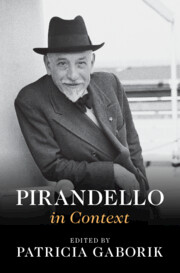Book contents
- Pirandello in Context
- Pirandello in Context
- Copyright page
- Dedication
- Contents
- Figures
- Contributors
- Preface
- Acknowledgments
- Chronology
- List of Cited Titles in Translation and the Original Italian
- Part I Places
- Part II Institutions
- Part III Interlocutors
- Chapter 11 Marta Abba
- Chapter 12 Massimo Bontempelli
- Chapter 13 Gian Francesco Malipiero
- Chapter 14 Georges Pitoëff
- Chapter 15 Max Reinhardt
- Chapter 16 George Bernard Shaw
- Chapter 17 Benedetto Croce and Adriano Tilgher
- Part IV Traditions and Trends, Techniques and Forms
- Part V Culture and Society
- Part VI Reception and Legacy
- Further Reading
- Index
Chapter 11 - Marta Abba
from Part III - Interlocutors
Published online by Cambridge University Press: 14 March 2024
- Pirandello in Context
- Pirandello in Context
- Copyright page
- Dedication
- Contents
- Figures
- Contributors
- Preface
- Acknowledgments
- Chronology
- List of Cited Titles in Translation and the Original Italian
- Part I Places
- Part II Institutions
- Part III Interlocutors
- Chapter 11 Marta Abba
- Chapter 12 Massimo Bontempelli
- Chapter 13 Gian Francesco Malipiero
- Chapter 14 Georges Pitoëff
- Chapter 15 Max Reinhardt
- Chapter 16 George Bernard Shaw
- Chapter 17 Benedetto Croce and Adriano Tilgher
- Part IV Traditions and Trends, Techniques and Forms
- Part V Culture and Society
- Part VI Reception and Legacy
- Further Reading
- Index
Summary
Focusing largely on an extraordinary epistolary collection, this chapter discusses the relationship between Luigi Pirandello and Marta Abba and, in particular, the impact she had on his dramatic writing. The author’s acquaintance with Marta Abba, which began in 1925, arguably changed the trajectory of his work as a playwright: From that point on, he would increasingly center his plays on female characters, many of which he wrote explicitly for Abba and in her likeness. Her importance in his life can be seen in their letters, which reveal their bond, their deep respect for one another as colleagues and as experts in theatrical matters, and the extent to which he valued her perspective as he crafted his new plays. At the same time, one can glimpse in the plays how Pirandello’s unreciprocated romantic feelings for his muse and star actress shaped his conception of artistic creation as a substitute for love, desire, and procreation.
- Type
- Chapter
- Information
- Pirandello in Context , pp. 87 - 94Publisher: Cambridge University PressPrint publication year: 2024

